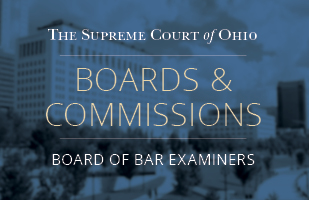Bar Examiners: Legal Profession Gatekeepers

The Board of Bar Examiners is a diverse group of attorneys that measure whether prospective Ohio lawyers “make the grade.”

The Board of Bar Examiners is a diverse group of attorneys that measure whether prospective Ohio lawyers “make the grade.”
Editor’s Note: This story is part of a series on the Ohio Supreme Court’s boards and commissions.
Becoming an Ohio attorney is a years-long endeavor with multiple requisites, including undergraduate and law degrees.
The last hurdle is the Ohio Bar Examination, which is managed by the Board of Bar Examiners – a group of people responsible for developing, administering, and grading the tests that a prospective attorney’s aptitude.
“They’re the gatekeepers for those who are admitted to the practice of law in Ohio,” said Tiffany Kline, the Ohio Supreme Court’s assistant director for bar admissions.
In 2018, the Supreme Court unanimously approved the Uniform Bar Examination (UBE). The newly adopted format was changed, moving away from a state-focused model in order to give successful applicants the flexibility to become licensed in 38 other UBE-administered states without another examination.
The two-day exam period has three components:
- Multistate Bar Examination – which is 200 multiple-choice questions
- Multistate Performance Test (MPT) – assesses the ability to use fundamental lawyering skills in two real-life situations
- Multistate Essay Examination (MEE) – six essay questions
The 18 board members are attorneys with expertise in various disciplines of law. A diverse class of specialists ensures a wide depth of knowledge from the many fields of law to best measure the competency of applicants.
Appointed by the justices to five-year terms, the group meets twice annually – once before the winter exam and once before the summer exam.
Central to the new process is how the interpretative portions of the exam – the MPT and MEE – are graded. To have consistent scoring among all the examiners, the board holds a “calibration session” to discuss the range of adequate explanations from exam-takers.
Other items on the board’s agenda include updates from the Court’s Office of Bar Admissions on any changes in the testing format, including the recent transitioning to remote testing due to the coronavirus pandemic. As part of an ongoing review process, the board revisits issues, such as technical or logistical concerns, from the previous exam. The group also evaluates testing accommodations, which includes granting and facilitating modified arrangements for applicants with disabilities.
“The board takes this work very seriously. It’s very important to them,” Kline said. “We have to make sure the exam goes right. It has to go smoothly.”When grading the exam, each board member has 30 days to assess their allotted set of tests. Applicants can number between 250 and 1,000 individuals, depending upon the exam cycle.
After the initial evaluations, there’s a second round of grading to double check the work of examinees who fall within 2 points of the required score of 270 to pass. This process, lasting one to two weeks, places scrutiny on the close calls for those who come up just short of passing.
The board’s final responsibility is investigating allegations of cheating.
An unknown percentage of those who pass the exam may consider the test as a means to an end and never give it another thought after they’re done.
But board members work to make the application process more efficient and inclusive and see the significance of their commission in maintaining the high standards of the legal profession in Ohio.
Service on the Board of Bar Examiners is one of the many ways an attorney can give back to the profession. The Board of Bar Examiners, like other boards and commissions, has a need for volunteers to share in maintaining the integrity of the profession. The justices of the Ohio Supreme Court appoint the members of the board and are always grateful for applications from those willing to serve.


